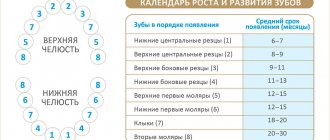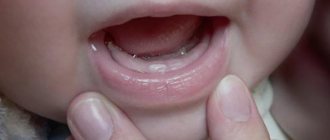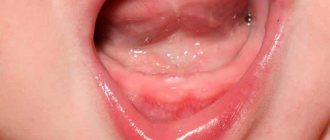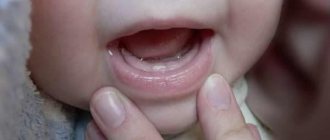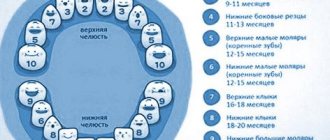At the age of six months, the baby begins to cut his first baby teeth. This is both a joy and a very problematic period.
The process of teething in a child takes about two years. So, for all 2 years, the baby and his family have to worry about the pain that accompanies teething? Not at all! Today there are a lot of methods and drugs that act as pain relievers during teething.
There are children who easily endure various age-related physiological processes, including the appearance of their first teeth. But, as a rule, most children react to such changes quite sharply - they lose sleep, lose appetite, become mischievous, and show their poor health in other ways. How can we help them?
Symptoms of the onset of baby teeth
First of all, parents need to be able to recognize when the teething process has begun. The appearance of the first teeth has the following symptoms:
- inflammation and redness of the gums;
- increased salivation;
- change in the child’s appetite (the baby may refuse food altogether or, conversely, try to eat inedible);
- biting and attempts to gnaw everything on the part of the child (due to the fact that the gums itch during teething);
- not a significant increase in body temperature for a period of 1-2 days (due to the fact that an increased amount of biologically active substances is released in the body);
- slight (up to 3 days, with a frequency of up to 3 times a day) diarrhea, due to the fact that salivation increases and a lot of saliva enters the child’s gastrointestinal tract;
- mild runny nose (clear nasal discharge for about 4 days);
- wet cough (also due to increased salivation);
- lack of sleep (due to discomfort).
What problems can arise during teething?
- Teeth cutting too late. A period of more than 2 months from the moment when they should have started to erupt is considered late.
- Teeth are cutting too early. Although there are cases when a child is born with teeth already erupted. But still, if teeth begin to appear for the most part too early, this is a cause for concern.
- The appearance of teeth outside the dentition.
- Incorrect formation of newly erupted teeth.
- Violation of the order of eruption of the incisors or the absence of one of the teeth.
If symptoms (fever or runny nose) last longer than a couple of days, the child should be seen by a doctor immediately!
Baby's behavior during teething
When children are teething , parents are very worried about how the baby will survive this rather long and often difficult period.
We will not repeat ourselves about the order and pattern of growth of baby teeth. Another of the most common questions is: how many baby teeth do children have? We answer: normally, by the age of one year, the baby should have 8 full incisors - four on the bottom and four on top. By the age of 2 - 16, and by 2.5-3 years all milk teeth - 20 - have grown. By the way, all baby teeth fall out without exception and permanent teeth grow in their place.
Symptoms of teething in a child
But the symptoms of teething in a child can be completely different. Some children tolerate this time calmly; parents do not even know that the child is teething. It’s just that at one moment mom notices that the teeth are already there. Other children show obvious anxiety - their gums constantly itch, they try to chew something, rub their gums against each other, and there is constant salivation. Often the baby becomes whiny, irritable, and sleep is disturbed. The child may even refuse food because it hurts. In these cases, special gels for relieving painful sensations, which are sold in pharmacies, help well. You should also purchase a special silicone finger tip for wiping your gums and cleaning the first teeth that appear. If the mother regularly carries out this procedure from a very early age of the baby (3-4 months), in the future there will be no problems with the child brushing his teeth independently.
restless behavior during teething may also be due to many complications of this period and individual reactions of the body. This may include fever, upset stomach, vomiting, diarrhea, runny nose, and increased drowsiness. Much less often, there may be skin rashes, as well as isolated convulsions, which are most often associated with high fever.
If you are concerned about the baby's condition, especially the child's high temperature during teething , be sure to call your local pediatrician or contact our clinic for advice. We do not recommend listening to the advice of random people, and even grandmothers. It’s just that modern medicine has come a long way, and many of grandma’s recipes are outdated, especially since most of them are completely ineffective. Only a professional can competently assess the situation, including the correct formation of the bite, differentiate the symptoms of teething from other diseases, and choose the most affordable way to help the baby during this crucial period of his life. How to help a child, what you can do and what you absolutely cannot do - read the article “How to help a child when teething.”
The order of appearance of baby teeth
The appearance of teeth has a strict sequence, which indicates the correct formation of the masticatory apparatus:
- At the age of 9-10 months, the first lower and upper incisors appear.
- Up to a year (up to 12 months), the second upper and lower incisors erupt.
- The first upper and lower chewing teeth will appear at the age of 12-19 months.
- Fangs erupt between 16 and 22 months of age.
- The child will acquire second upper and lower chewing teeth between 20 and 30 months.
In general, the process of teething is the natural course of things. And it’s definitely not worth accelerating it with mechanical influences. But it is possible to help a child survive it with the least discomfort. The first symptoms of teething may appear a month or two before the actual appearance of the tooth! To prevent a child from feeling discomfort all the time, there are many everyday tricks and even medications designed to relieve pain and inflammation from children’s gums.
“Painkillers” for teething in children: types, methods of use
To facilitate the process of teething, you can use various painkillers, local and general. What types of means are there and are there any restrictions on their use?
To make the process of teething as easy as possible, dentists recommend massaging the child’s gums. The gums are massaged for 1-2 minutes with gentle circular movements with clean hands, while the fingers are wrapped in a sterile napkin. In this case, Asepta napkins, made in the form of a fingertip, have proven themselves to be excellent. Extracts of chamomile and witch hazel in the impregnation have a soothing and anti-inflammatory effect on inflamed gums, reducing pain and swelling.
In addition, it is important to constantly wipe your baby's drool if it drips onto the chin to avoid irritation or rash there. Teething is accompanied by copious salivation; during this period the child must be carefully monitored.
It is necessary to constantly maintain contact with the baby, take him in your arms often and try to distract him with some activities. It is recommended to talk a lot with the child in order to “drown out” his pain.
During teething, you can offer your baby special teethers - toys of various ring-shaped shapes rubberized or filled with cooling thermogel. Before giving such a thing to your child, experts recommend cooling it a little in the refrigerator. But not too much, since the child will refuse very cold toys, and if he does not refuse, he may catch a cold due to contact with a surface with a low temperature.
If the baby refuses special devices for teething and prefers to chew something chosen independently, there is no need to prevent this. However, it should be borne in mind that the object that the child puts into his mouth must be:
- is devoid of sharp protruding parts so that the baby does not cut himself;
- without small parts that a child can “gnaw off” and swallow/chokes on;
- consist of a substance that will not harm the child upon contact.
Many children love to chew on bread crusts or bagels while teething. This is a rather dangerous activity, since the child may choke on crumbs or damage the delicate oral cavity with them.
How to help your baby teething
As an advertisement
Teething is an integral part of childhood and an important stage in a child’s development. For parents, this is new joy and new stress. Unfortunately, not all children tolerate the process of the appearance of their first teeth easily, and most parents remember this period as a series of sleepless nights. The child becomes restless, cries, sleep is disturbed, salivation increases, and the gums become swollen and red. Sometimes body temperature rises, appetite decreases and digestion is disrupted. The baby tries to put everything that comes to hand into his mouth.
On average, children erupt one new tooth every month, from 6 months of age until approximately 3 years of age, until they have a total of 20 baby teeth. The timing and order of teeth appearance may vary for each child.
Gum massage will help ease your baby's condition.
Massage can be performed either with your finger or with the help of special soft brushes and teethers. Chill the teether in the refrigerator for a short time, making sure it is cool and not cold like an ice cube. If the object is too cold, it can harm your gums and your baby. To facilitate teething, you should not give your child dry goods, bagels, a piece of apple or carrot, as crumbs can get into the respiratory tract.
Massage helps improve local microcirculation and additional anti-inflammatory effects, and coolness soothes the gums, dulling the sensitivity of the nerves that transmit pain, and gives relief to the child for a while. When massaging, you can use special dental gels for the gums.
How to choose a teething gel?
It is better to give preference to safer products based on natural ingredients. Avoid using topical anesthetics containing lidocaine as they should only be used as directed and under the supervision of a physician. Gel for gum massage “ Pansoral first teeth”
will help the child endure a difficult period easier. “Pansoral first teeth” is produced in France based on natural extracts of marshmallow, Roman chamomile and saffron. These medicinal herbs are known for their anti-inflammatory, antiseptic, soothing and softening effects. “Pansoral first teeth” is designed specifically for babies. The gel does not contain sugar, ethanol, or synthetic painkillers such as lidocaine or choline salicylate.
Recommendations for use of Pansoral first teeth
Wash your hands thoroughly and apply a small pea-sized amount of gel to your fingertip. Gently massage the gel onto your gums. "Pansoral first teeth" can be used as needed throughout the entire period of teething.
Pierre Fabre LLC 119435, Moscow, Savvinskaya embankment, 15. Tel., fax. www.pierre-fabre-russia.ru
IS NOT
MEDICINE.
Before use, consult a specialist.
Products by topic: [product](Pansoral)
When to sound the alarm
In those places where teeth erupt, many biologically active substances are released, for example, histamine, leukotrienes, prostaglandins, etc. They cause the symptoms that every parent is familiar with:
- Temperature increase. Normally, when teething, the temperature should be low-grade, that is, no more than 38 degrees;
- Swelling, pain and redness of the gums.
This is a normal baby reaction to teething. As a rule, the baby refuses to eat, but at the same time pulls toys into his mouth to chew on them. Due to the fact that the child constantly chews something, the nerves of the gums are irritated and a lot of saliva is released, and since the child does not yet know how to control saliva, it flows out of the mouth. The child also becomes more excitable than usual - he sleeps less, is constantly capricious, and becomes irritable.
Life hack: to help your child and relieve tooth pain, buy a special teething toy. This toy can be filled with water and placed in the refrigerator. When the baby chews on it, the toy will cool the inflamed gums and thereby partially relieve the pain.
But there are symptoms that parents often confuse with a normal reaction to the appearance of teeth:
— Digestive disorders – diarrhea, vomiting, loose stools;
— Temperature above 38-39 degrees, which does not subside for several days;
- Cough, rash, swelling.
These symptoms indicate that there is an infection in the child’s body that needs to be treated.

